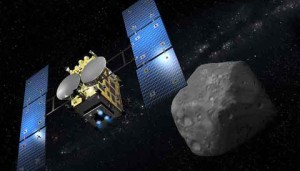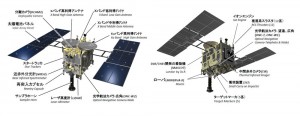The Japanese asteroid-sample mission launched successfully. With luck, in six years its sealed capsule will return to Earth with samples of a primitive, carbon-rich asteroid.
On December 3rd, the Japan Aerospace Exploration Agency (JAXA) launched the spacecraft Hayabusa 2 on an epic journey — to an asteroid and back again. The intrepid asteroid explorer will rendezvous with near-Earth asteroid 1999 JU3 and obtain samples from its surface before returning to Earth.

Akihiro Ikeshita / JAXA
The Hayabusa 2 payload was carried aloft by an H-IIA rocket, which took off from the Tanegashima Space Center in southern Japan at 1:22 p.m. JST (4:22 Universal Time), after several days of delay due to bad weather.
This is the successor to the first Hayabusa mission, which was the first (and so far only) spacecraft to bring bits of an asteroid back to Earth. The first Hayabusa limped home with particles from 25143 Itokawa in June 2010, after a harrowing number of problems.
Hayabusa 2’s target asteroid, 1999 JU3, is about 900 meters (3,000 feet) in diameter and generally circles the Sun between the orbits of Earth and Mars, rotating with a period of about seven and a half hours. It's a C-type, or carbonaceous, asteroid.C-type asteroids are the most common type of asteroid, dark gray, and often seen in the main asteroid belt’s outer regions. Planetary scientists find them especially interesting because they are thought to contain significant quantities of water and organic compounds.
The origin of water on Earth is not fully understood, but many scientists think it was brought to Earth by carbonaceous fragments bombarding the primordial planet. Because asteroids formed early in the evolution of the solar system and have changed little since then, they may hold tantalizing clues from this era, 4.6 billion years ago. Analysis of the samples from 1999 JU3 could help scientists understand our watery Earth’s origins and reveal the types of organic compounds that formed in the early solar system.
Hayabusa 2 will be the third spacecraft to land on an asteroid (after NASA's NEAR-Shoemaker and the original Hayabusa) and — if it works — the second to return samples of an asteroid to Earth. The original Hayabusa mission studied an iron-rich S-type (silicate-rich) asteroid named 25143 Itokawa.

JAXA
Similar in design to its predecessor, the main body of Hayabusa 2 measures 1.6 by 1.4 by 1.0 meters, though its solar-cell panels span 6 m. It weighs in at a total of 600 kg (1,300 pounds), including fuel. Although Hayabusa 2 looks like its predecessor, the team has beefed up the technology aboard the spacecraft.
One new feature of Hayabusa 2 is a "speeding bullet": the spacecraft’s Small Carry-on Impactor will use an explosive device to shoot a 2-kg copper projectile at the asteroid at a velocity of 2 km per second, creating an artificial crater. The spacecraft will deploy a camera to watch the impact (the main craft itself will hide behind the asteroid), and the debris will be sampled to study pristine material from beneath the asteroid’s surface.
In addition to taking samples during brief touch-downs in three locations on the asteroid’s surface, Hayabusa 2 will study 1999 JU3 remotely, using its near-infrared spectrometer and thermal-infrared imager to examine the temperature variations and mineral composition of the asteroid. Hayabusa 2 will also bring along several traveling companions to make close-up observations. Three small Minerva II rovers (short for MIcro/Nano Experimental Robot Vehicle for Asteroid) and a lander, Mascot (Mobile Asteroid Surface Scout), will make detailed measurements at the surface.
For now, Hayabusa 2 has a long journey ahead of it. After building up some speed swinging by Earth in 2015, it will meet up with 1999 JU3 in 2018 and stay there for 18 months before returning home in 2020 — hopefully with a precious payload.
Shopping for the holidays? Check out the 12 Days of Deals in our online store www.shopatsky.com.
 0
0
Comments
You must be logged in to post a comment.